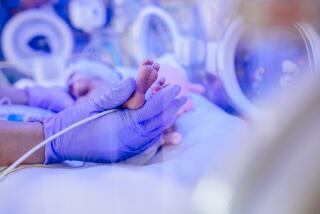Infant Screening Rates Rise in U.S.
- Share via
The percentage of newborns screened for more than 20 of the 29 treatable genetic disorders suggested by the American College of Medical Genetics nearly doubled in the last year, but about a third of the 4 million babies born each year are screened inadequately, according to a report issued Monday.
“All babies across America should receive the benefits of being screened,” said Dr. Jennifer L. Howse, president of the March of Dimes, which produced the report. “Whether a baby is screened and gets the immediate treatment necessary to lead a healthy life should not depend on which state they are born in.”
All children born in the U.S. are tested for hypothyroidism and the blood disease sickle cell anemia. They are also tested for the metabolic diseases phenylketonuria and galactosemia.
The number and type of additional tests a newborn receives are determined by each state.
In 2004, at the federal government’s request, the American College of Medical Genetics recommended a battery of 29 tests, including a hearing test and blood tests for 28 rare but serious diseases. All of the conditions can be treated or managed if caught in time.
A team of cardiologists is expected later this week to call for an electrocardiogram for each newborn to test for heart disease too.
California began testing for 29 disorders in 2002 using money from private grants and insurance companies, but dropped back to the basic four tests in 2003 when the grants expired.
Beginning last August, however, state funding became available; now, California screens for 26 maladies, placing it in the upper tier of testing states.
Thirty-one states require more than 20 of the suggested tests, up from 23 states in 2005, according to the March of Dimes. As a result, 64% of babies are screened, compared with 38% in 2005.
Eight states -- Arkansas, Kansas, Montana, New Mexico, Oklahoma, Pennsylvania, Texas and West Virginia -- require fewer than 10 of the tests.
Comprehensive programs that test for all 29 of the disorders are in place in five states -- Iowa, Maryland, Mississippi, New Jersey and Virginia -- and the District of Columbia. Those areas account for 9% of babies born in the U.S.
No one disputes the usefulness of newborn screening. Cost is the issue, particularly the initial investment. Many of the tests are performed with a tandem mass spectrometer, which costs nearly half a million dollars.
The full battery of tests costs less than $100 per infant. But, according to the March of Dimes, the cost of the initial hospitalization for an infant with an undiagnosed metabolic disorder averages more than $25,000.
The March of Dimes estimates that 16,000 to 20,000 children are diagnosed with one of the 29 disorders each year. About 4,000 of them have metabolic disorders; most of the others have hearing loss.
The March of Dimes’ goal is to have every U.S.-born infant tested for all 29 disorders by the end of 2008. Given the current rate of progress, Howse said, that goal is in reach.
More to Read
Sign up for Essential California
The most important California stories and recommendations in your inbox every morning.
You may occasionally receive promotional content from the Los Angeles Times.













